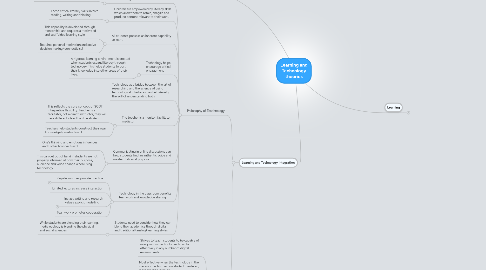
1. Learning and Technology Integration
1.1. Philosophy of Teachnology
1.1.1. Students must be capable of using various technologies to write effectively in any number of digital environments
1.1.1.1. Sources of information include:e-mail, communities, conversations (connectivist)
1.1.2. Children are empowered by literacy skills which allow them to retain, analyze and produce content relevant to their work.
1.1.2.1. These critical literacy skills involve reading, writing and thinking
1.1.3. All students possess an inherent capability to learn.
1.1.3.1. This capability is developed through mentorship and requires a motivated and scaffolded learning style
1.1.3.2. Requires personal motivation and active decision making (connectivist)
1.1.4. Technology helps encourage critical engagement
1.1.4.1. A rigorous learning environment is created when students expand literacy through technology. This helps students to port their knowledge into other areas of their lives.
1.1.5. Technology as a bridge between the art of researching and the science of using technological interfaces can help develop the skill of understanding both
1.1.6. The teacher is a monitor, facilitator, mediator
1.1.6.1. This reflects the core concept of SCOT: Interpretive flexibility. Teacher is a facilitator, not a direct instructor, they will have different ideas than the student.
1.1.6.2. Teachers help students construct their own knowledge (constuctivist)
1.1.7. Communicating in online discussions can help students find an authentic voice and master rhetorical purpose
1.1.7.1. One's thinking and emotions influences each other (connectivist)
1.1.7.2. This can get out of hand if students are not properly informed of how their purpose, audience and voice change when using technology
1.1.8. Technology in the classroom benefits teamwork and knowledge sharing
1.1.8.1. Regular routines provide practice
1.1.8.1.1. This helps develop cognitive schemas
1.1.8.2. Limited lectures increase interaction
1.1.8.3. Inclass writing and research values explicit modelling
1.1.8.3.1. Helps to develop ideas and then reflect on them (constructivism)
1.1.8.4. Teamwork promotes cooperation
1.1.9. Students need to consider how they can blend their academics through digital and traditional (analog) learning styles
1.1.9.1. While students are blending their learning, media ecology is blending the physical and social sciences
1.2. TPACK
1.2.1. Strives to teach students to be capable of using various technologies to write effectively in any number of digital environments
1.2.2. Most effective when the technology in the classroom is focused on student-centered, individualized learning
1.2.3. "writing" is practiced through blogging and social networking
1.2.4. Facilitates writing, in a way that students enjoy
1.2.5. Easy manipulation of sound, video and images allows for strong presentations
1.2.6. Allows risk-taking because it can be so easily undone
2. Technology
2.1. Media Ecology
2.1.1. The study of media environments: technology, information and complex communication systems
2.1.2. "How media communication affects human perception, understanding, feeling and value; and how our interaction with media facilitates or imposes our chances of survival" (1970. Neil Postman, "The Reformed English Curriculum".)
2.1.3. Neil Postman was the first to formally address it
2.1.4. Still very "new"
2.1.5. A movement towards integration of physical and social sciences
2.2. SCOT
2.2.1. Social Construction of Technology
2.2.2. Within the field of sciences and social studies
2.2.3. Human action shapes technology
2.2.4. Used in analyzing the failure or success of a technology
2.2.5. Core concepts
2.2.5.1. Interpretive flexibility - each type of technology has a different meanings for different age groups.
2.2.5.1.1. This is interesting because something that means one thing to a classroom teacher, could serve a completely different purpose to his/her students
2.2.5.2. Relevant social groups - Users vs. producers, consumers socioeconomic status, competing producers etc.
2.2.5.3. Design flexibility - the multiple ways of constructing a technology. it's design reflects only one group's interpretation
2.2.5.4. Problems and conflicts
2.2.5.5. Closure
3. Learning
3.1. Cognitive Load
3.1.1. Involves structures of working memory, long term memory
3.1.2. Schemas come with repeated effort and effective practice
3.1.3. Schemas lead to automation: doing something without conscious thought
3.1.4. 3 types
3.1.4.1. Extraneous
3.1.4.1.1. Caused by poorly organized instructional designs that inhibit working memory from building schemas into long term memory.
3.1.4.2. Intrinsic
3.1.4.2.1. Caused by overly complex elements interacting in working memory. "Sensory overload". (ex: a busy website)
3.1.4.3. Germane
3.1.4.3.1. Caused by effortful learning which encourages schemas to develop and lead to automation
3.1.5. Uses in teaching
3.1.5.1. Knowledge Compression = Chunking information into meaningful chunks using graphic organizers and mnemonic devices can help schemas develop
3.1.5.2. Clear, elegant instructional designs can help avoid "cognitive traffic jams". The brain will find relief and avoid split attention caused by sources presented simultaneously.
3.1.5.3. Repetition of isolated information to rehearse helps with automation. The more background knowledge of a subject, the easier this is.
3.2. Constructivist
3.2.1. People construct their own understanding and knowledge of the world through experiencing things and then reflecting on those experiences
3.2.2. When we encounter something new, we must consider it against what we already know.
3.2.3. We may throw away new information if it is irrelevant
3.2.4. Involves using active techniques, such as experiments, to create more knowledge
3.2.5. Must constantly ask oneself how an activity is helping to gain understanding
3.2.6. * learning HOW to learn
3.2.7. Will develop increasingly strong abilities to integrate new information
3.2.8. Teachers help students construct their own knowledge
3.3. Connectivist
3.3.1. Requires personal motivation and active decision making
3.3.2. Learning is a process of connecting specialized information sources, also known as "nodes"
3.3.3. The capacity to know more is important, rather than that what is already known. Knowing where to find information is more important that actually knowing it by heart.
3.3.4. Learning and knowledge rest in a diversity of opinions
3.3.5. requires different approaches to learn
3.3.6. Nurturing and maintaining connections are necessary to attain more information
3.3.7. Currency = accurate, up-to-date information
3.3.8. Sources include: courses, e-mail, communities, conversations
3.3.9. One can learn from not necessarily human resources such as communities, networks and databases
3.3.10. One's thinking and emotions influence eachother
3.3.11. * learning is a knowledge creation process, not only knowledge consumption
